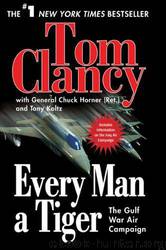Every Man a Tiger: The Gulf War Air Campaign by Tom Clancy; Chuck Horner; Tony Koltz

Author:Tom Clancy; Chuck Horner; Tony Koltz
Language: eng
Format: mobi
Tags: 1991, Persian Gulf War (1991), General, United States, Middle East, Military, Biography & Autobiography, Aviation, Strategy, Persian Gulf War, History
ISBN: 9780425219133
Publisher: Berkley Books
Published: 2008-01-08T04:15:50+00:00
★ On October 9, Buster Glosson and a team from CENTCOM left for Washington to brief the air campaign to General Powell (on October 10) and to the President and his chief advisers (on October 11). Heading the team was Major General Bob Johnston, the CENTCOM chief of staff. The other Army briefer was Lieutenant Colonel Joe Purvis.
Before the briefers left Riyadh, Schwarzkopf made it forcefully clear to Johnston that he was not recommending any of the ground schemes Purvis was going to brief. His aim was to generate the question “What do you need to develop an acceptable ground campaign?” With the expected answer being “A heavy corps.”
En route to President Bush, the briefings went through the usual reviews, which agreed that while the air campaign was well constructed and credible, the focus of the land campaign on sending forces directly into the teeth of the Iraqi defenses appeared unimaginative. Of course, it was not a lack of imagination that had given birth to this unhappy situation, it was a lack of friendly forces.
The briefing to the President had mixed results. The air briefing delivered by Buster Glosson was generally accepted, though not without questions about the plan’s assumptions of success. It simply looked too good. It was hard to accept its claims.
It’s worth looking at what lay behind these doubts—an outdated mind-set that did not yet understand the full impact and capabilities of modern airpower. Let’s examine a pair of facts:
First, the reputation of airpower had been created long before by air campaigns whose success had at best been mixed—the P-40s at Kassarine Pass, the B-17s over Germany, the F-100s bombing the Vietnam jungle. If such actions were paradigms for all air campaigns, then President Bush and his advisers had good reason to throw hard questions at Buster Glosson. How could any human endeavor go as well as he promised?
Second, technology had outrun conventional perceptions. In the years after Vietnam, airpower had taken a technological leap comparable to the shift from cannonballs to rifled shells. Now there were laser-guided bombs on Stealth aircraft, A-10s with Maverick missiles, and 30mm cannon shooting up tanks and APCs in the desert. The air campaign would go that well.
In the event, despite attempts to poke holes in it, the air briefing stood up.
The Army briefing didn’t fare so happily. For reasons unknown to Chuck Horner, it was never made clear that General Schwarzkopf had intended all along to offer Joe Purvis’s plan as a straw man that would justify the extra corps the CINC wanted very badly. To the best of Horner’s knowledge, Schwarzkopf had told Colin Powell time and again, “This plan is not what I want, but I can’t do what needs to be done without another corps at the minimum.” So Joe Purvis, courageously, stood up and got pummeled (and by implication, Norman Schwarzkopf got pummeled with him). The Army plan was called unimaginative, timid, risky. There were jokes about it: “Hey, diddle diddle, right up the middle.” All
Download
This site does not store any files on its server. We only index and link to content provided by other sites. Please contact the content providers to delete copyright contents if any and email us, we'll remove relevant links or contents immediately.
| Civil War | Operation Desert Storm |
| Veterans | Vietnam War |
The Radium Girls by Kate Moore(10915)
The Templars by Dan Jones(4192)
100 Deadly Skills by Clint Emerson(4085)
Rise and Kill First by Ronen Bergman(4020)
The Doomsday Machine by Daniel Ellsberg(3737)
The Rape of Nanking by Iris Chang(3526)
Killing England by Bill O'Reilly(3461)
Hitler in Los Angeles by Steven J. Ross(3447)
Stalin by Stephen Kotkin(3091)
12 Strong by Doug Stanton(3059)
Hitler's Monsters by Eric Kurlander(2737)
Darkest Hour by Anthony McCarten(2650)
Blood and Sand by Alex Von Tunzelmann(2611)
The Art of War Visualized by Jessica Hagy(2416)
Hitler's Flying Saucers: A Guide to German Flying Discs of the Second World War by Stevens Henry(2301)
The Code Book by Simon Singh(2217)
The Second World Wars by Victor Davis Hanson(2136)
Babylon's Ark by Lawrence Anthony(2073)
Tobruk by Peter Fitzsimons(2065)
